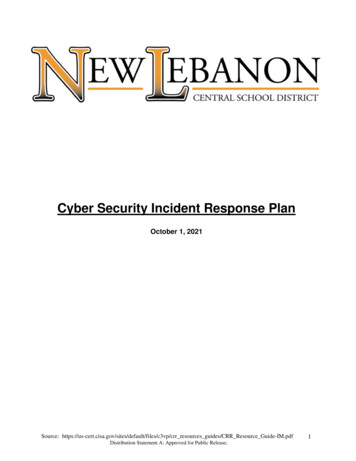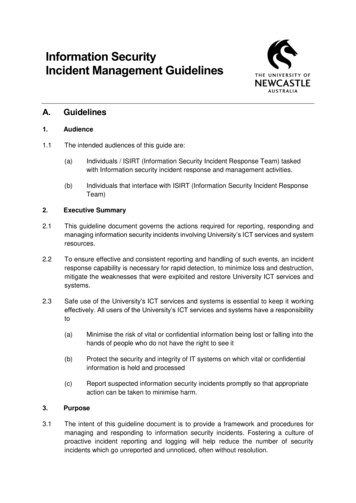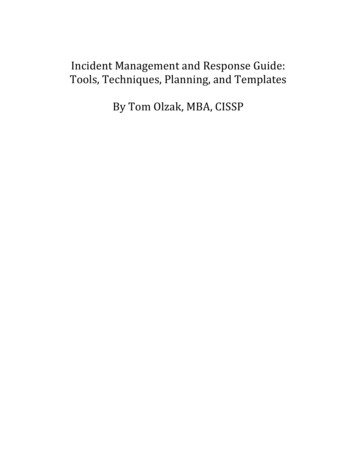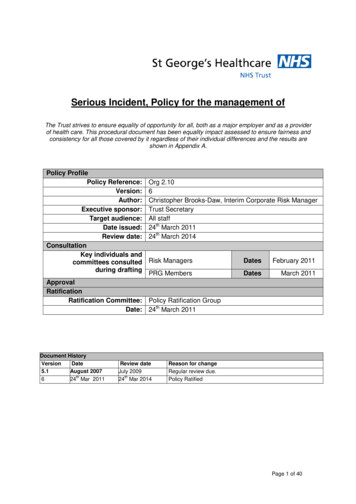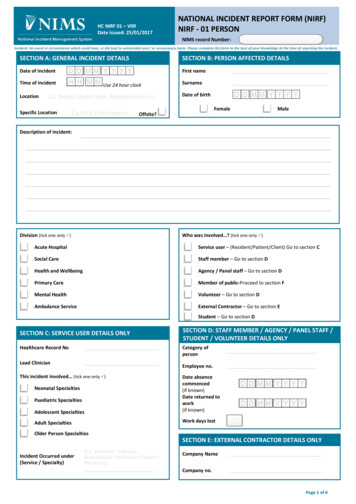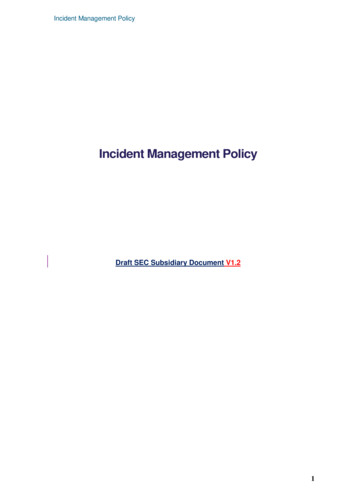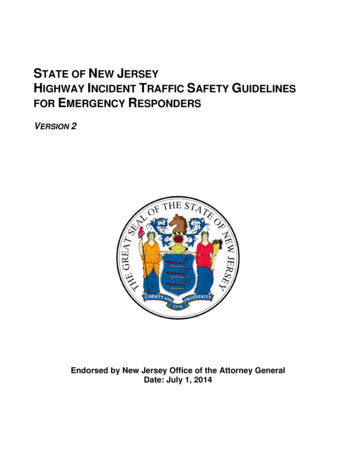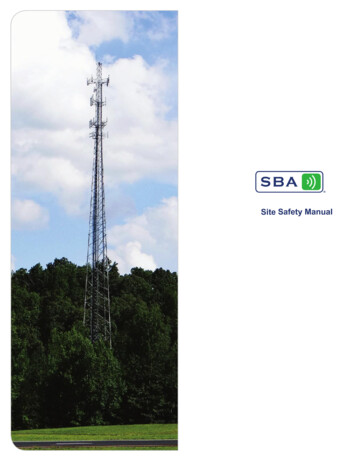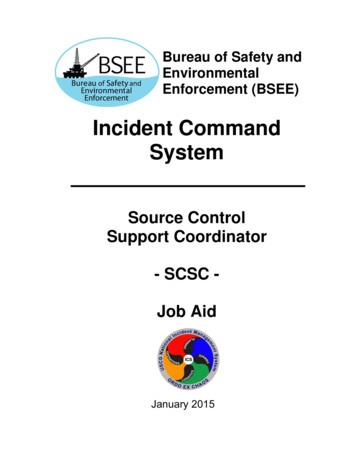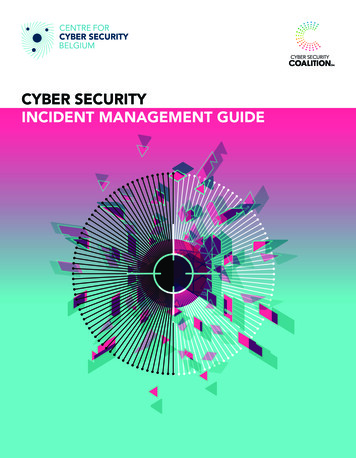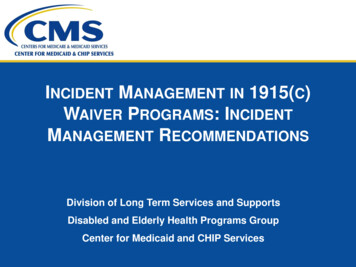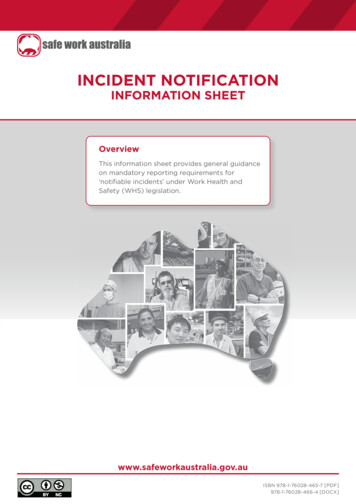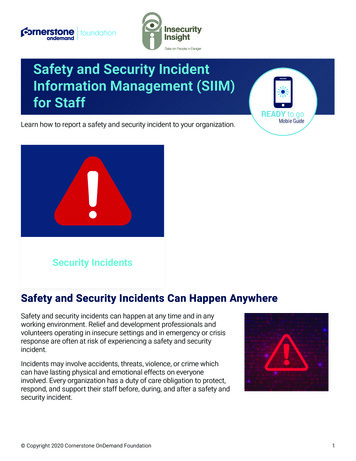
Transcription
Safety and Security IncidentInformation Management (SIIM)for StaffLearn how to report a safety and security incident to your organization.Security IncidentsSafety and Security Incidents Can Happen AnywhereSafety and security incidents can happen at any time and in anyworking environment. Relief and development professionals andvolunteers operating in insecure settings and in emergency or crisisresponse are often at risk of experiencing a safety and securityincident.Incidents may involve accidents, threats, violence, or crime whichcan have lasting physical and emotional effects on everyoneinvolved. Every organization has a duty of care obligation to protect,respond, and support their staff before, during, and after a safety andsecurity incident. Copyright 2020 Cornerstone OnDemand Foundation1
Why Should You Report an Incident?It is critical for all staff to report safety and security incidents. Your organization can only act if theyknow about an incident. Reporting an incident will enable your organization to respond immediately,help reduce the impact of the incident, and take actions to prevent incidents from happening in thefuture. Even if the incident does not seem critical to you or does not directly affect your organization,reporting it could help inform key decisions about operations and programs in your organization.Reporting Incidents Helps You Process and understand what happened Receive support (additional medical care, counseling, legalaction) Learn how to mitigate risks and make informed decisionsregarding personal safety and security at work Learn how to prevent similar incidents from happening in thefuture Better understand security procedures and how to supportother colleaguesReporting Incidents Helps Organizations Respond to the incident and provide immediate assistance toeveryone involved Learn from the incident to better prevent, prepare for, andrespond to future incidents Meet duty of care obligations by improving the safety andsecurity of employees and others Understand the operational context to inform key decisionsfor security measures and improving access to communities Inform strategic decision-making for programming, safetyand security, human resources, finance, and advocacy Identify and address underlying structural and systemicissues, discrimination, and/or bias that may have caused theincident or an employee to be a specific target Determine inclusive ways to improve the safety and securityof diverse profiles of staff, taking into consideration howpersonal characteristics may make individuals vulnerable todifferent internal and external threats Copyright 2020 Cornerstone OnDemand Foundation2
What is an Incident?Each organization will have their own policy on what safety and security incidents need to be reportedby staff and specific reporting procedures to follow. Consider the different aspects of an incident tohelp you report it and support your organization with learning from and responding to the reportedincident.Defining an IncidentAn incident can be an event in which: Employee safety or security was compromised A dependent or other third party was injured/harmed duringorganizational activities Organizational property or assets were stolen, damaged, or putat risk There was interference with programming and operations The organization’s independent work was compromised The organization’s reputation was put at risk or damagedInternal vs ExternalAn incident can involve and/or affect The organization Employees People outside the organization (partners, other NGO staff,community members, the public)Critical vs Non-criticalIncidents can be critical and non-critical: Critical incident the organization’s response requiresusing additional measures and resources beyond normalorganizational procedures. Examples: kidnapping, death Non-critical incident the organization’s response uses normalorganizational procedures. Example: road traffic accident withno injury or severe damage Copyright 2020 Cornerstone OnDemand Foundation3
ImpactAn incident can impact: The safety, security, and wellbeing of yourself, colleagues, and/or others Your organization’s ability to:ƈ Conduct operationsLJ Deliver aid and servicesLJ Achieve its objectivesAccident vs Intentional ActAn incident can be an accident or an intentional act: Safety incident an accident Security incident an event that was caused intentionally by athird party to inflict harm on an individual, the organization, orother actors, or to negatively impact the delivery of aidClassificationYour organization will use a classification system that clearlydefines different types of incidents. This classification will helpsafety and security colleagues analyze the incident and compare itwith similar incidents to draw out lessons to be learned. Copyright 2020 Cornerstone OnDemand Foundation4
What is Safety and Security Incident Information Management?Safety and security incident information management (SIIM) is the process of collecting and usinginformation related to incidents to inform organizational decision-making. Safety and security incidentinformation management allows organizations to:1. Respond immediately to an incident.2. Learn from the incident to improve staff safety and security.3. Improve the organization’s understanding of the operational context to support the delivery ofprograms.4. Make informed strategic decisions across all departments of the organization.Incident reporting enables organizations to meet these four objectives to improve the safety andsecurity of staff, operations, and safe access to communities in need. Copyright 2020 Cornerstone OnDemand Foundation5
How to Report anIncidentKnow How to Report an IncidentYour organization will have its own requirements and procedures for reporting security incidents. It iscritical that you understand how to make a report BEFORE an incident takes place.Your organization should provide you with clear guidelines on how to report an incident and setexpectations on how they will use the information in the report to take next steps. Copyright 2020 Cornerstone OnDemand Foundation6
Step 1: Report ImmediatelyReport the incident to your organization as soon as it is safe for you to do so. If you are involved in acritical incident, you may need to contact the authorities, but this will depend on the context and yourorganization’s policy. If you are involved in a non-critical incident, your organization may ask you tocomplete a formal incident report instead of reporting the incident directly to the security focal point.Follow your organization’s reporting procedures to ensure that you and anyone affected by the incidentreceives the support they need. Make sure to provide your organization’s focal point with criticalinformation about the incident so they can respond effectively and immediately. Remember the 6 ‘Ws’:WHO was involved, WHAT happened, WHERE did the incident happen, WHEN did the incident happen,WHAT actions have been taken so far, and WHAT help is needed.Consider these questions when reporting a safety or security incident to your organization.Who was involved?Give the names, job titles, and information about staff and everyone involved in the incident.What Happened?Describe the details of the incident including any injuries, damage or loss.Where did the incident happen?Be specific about the location where the incident took place by providing the address, GPScoordinates, recognizable landmarks nearby, and/or describe how you arrived at the destination.When did the incident happen?Give the day and time when the incident occurred. The sooner you report an incident, the fasteryour organization can provide support and safeguard others.What actions have been taken so far?Explain if you have received help from anyone or a medical team, or if you have provided first aidto anyone.What help is needed?Be clear about the severity of any injuries and if you need your focal point to call the police, anambulance, or provide transportation.Keep in mind. Always report an incident as soon as possible, even if you are unsure about yourorganization’s reporting procedures. The safety and security of everyone involved is the main priority at this stage. If the incident is ongoing, provide updates as needed. You can provide more detailed information later in the Formal Incident Report. Copyright 2020 Cornerstone OnDemand Foundation7
Step 2: Complete a Formal Incident ReportAfter an incident takes place, complete a Formal Incident Report for your organization as soon aspossible.What is the purpose of the formal incident report?This report will gather detailed information about the incident to help your organization learn howto prevent and improve the response to similar incidents in the future.What information is collected in the formal report?The formal incident report will include detailed information about what happened, the eventsleading up to the incident, actions taken following the incident, the personal characteristics and/or circumstances of those involved in the incident, and any other relevant information.Who completes the report?You may be asked to complete the report yourself or your organization’s security focal point mayinterview you and complete the report with your help. This is a factual exercise, not an emotionaldebrief. Try to be as clear and factual as possible about what happened so trained colleagues canuse the information to investigate the circumstances around the incident.How will the information be used?The information you share about an incident can be used by your organization in a numberof ways, including informing decision-making around safety and security and other importantaspects of your organization’s work. If you are concerned that the incident might have beencaused as a result of your actions or a mistake you made, you may feel the need to not becompletely honest about what happened. Before deciding to withhold any information, ask yoursecurity focal point about the potential consequences of reporting. Copyright 2020 Cornerstone OnDemand Foundation8
Step 3: Learn from the IncidentAfter completing the Formal Incident Report, take time to reflect on what actions you or others couldhave taken, if any, to avoid the incident. Accidents and mistakes do happen, so it is important forboth individuals and organizations to learn from incidents to prevent and avoid similar incidents fromoccurring again. Remember that the purpose of learning from an incident is to reflect and prepare forthe future and not to assign blame.How will the information be used?Take time to think about the actions you and others involved took before, during, and after theincident. Consider if there were any actions you or your organization could have taken to preventor avoid the incident. Think about how you will apply lessons learned from the incident to preventsimilar incidents from occurring in the future. Remember that the aim of reflecting on lessonslearned is to identify practical and procedural solutions for the future that increase resilience. It isimportant that you do not blame yourself for the incident – accidents and mistakes do happen,and you are never to blame for the harm someone else has caused you.Were you a target?Structural, institutional, and personal prejudice can make some people more vulnerable and putthem at greater risk than others to particular threats. Your safety and security colleagues mayask you questions about your personal characteristics and individual circumstances (ethnicity,personal status, gender identity) to determine if you might have been targeted based on who youare or how others perceive you. If you feel uncomfortable disclosing this personal information,ask how the information will be used and kept confidential. If you feel that underlying structuraland systemic issues, discrimination, and/or bias are a factor that may have led to the incident ormade you a specific target, inform your safety and security colleagues about these issues as theyalso may not be aware of these risks or their own unconscious bias.Step 4: Inform Decision-makingThe information you share in your report about the incident will help inform decision-making in yourorganization.How will we apply what we have learned from the incident?The information you share in your report about an incident will help inform and improve yourorganization’s decision-making process regarding: Contextual analyses Risk assessments Security and safety procedures Policy Operations Programming Copyright 2020 Cornerstone OnDemand Foundation9
Example Scenario: Reporting a Carjacking IncidentHere is an example scenario for reporting a carjacking incident.Reporting ImmediatelyYou and an international staff member visiting from HQ are involvedin a carjacking incident while traveling to a field location. Theperpetrators take your organization’s vehicle and leave you and yourcolleagues on the side of the road. You and the other passengerare uninjured, but the driver was assaulted and needs medicalassistance. You call your organization’s focal point over the phone toreport the incident.Providing Key InformationTry to communicate clearly, focus on the facts, and provide keyinformation: WHO WAS INVOLVED: You provide the names, job titles, andother key information about the people involved in the incident:the national driver, you (a national program manager), and theHQ-based international staff member. WHAT HAPPENED: You explain the carjacking event andhow the perpetrators took the car. You clarify that you andyour international colleague are unharmed, but the driver wasassaulted and needs medical assistance. The losses include:the vehicle, your international colleague’s passport and laptopcontaining sensitive information about their personal identity, theorganization, and the local community. WHERE THE INCIDENT TOOK PLACE: Since you do not have theexact address of where you are and your GPS is not working, youdescribe the route you took so far and mention that there is ariver nearby. WHEN THE INCIDENT HAPPENED: You provide the day and timethe incident took place. WHAT ACTIONS HAVE BEEN TAKEN SO FAR: You mentionthat two people on the road have stopped to help the driver getmedical assistance. WHAT HELP IS NEEDED: You ask the focal point to arrangeemergency medical assistance for the driver, and to send avehicle for you and your colleague. Copyright 2020 Cornerstone OnDemand Foundation10
Completing a Formal Incident ReportA few hours after the carjacking incident, your organization’s securityfocal point asks to interview you so that they can complete theFormal Incident Report form.They ask you for detailed information about what happened, howthe driver was injured, the purpose of travel, and any circumstancesleading up to the incident, during the carjacking, and shortly after.Learning from the IncidentAfter analyzing the incident, your safety and security colleagues learnthat: In the past three months, four other carjacking incidents haveoccurred in the same location. Each incident involved international staff members either fromyour organization or from other organizations in the area. All incidents occurred when the international staff memberswere visibly traveling in the vehicle and identifiable as foreignemployees. The perpetrators of the incidents were identified as members of aparticular armed group.This information could explain why your vehicle was targeted inthat location. Your colleague was sitting in the front of seat of thevehicle without tinted windows which made them easily visible andidentifiable as a foreign employee.Your safety and security colleagues also discovered that the driveris a member of an ethnic group with which the armed group has ahistory of conflict. Therefore, historical ethnic tensions in the areacan explain why the driver was physically assaulted but the othertravelers were left unharmed. Copyright 2020 Cornerstone OnDemand Foundation11
Informing Decision-makingYour safety and security colleagues use the information provided inthe report to inform further contextual risk assessments and to planthe following actions: Establish additional travel restrictions in the area where theincident took place. Include ethnicity in the organization’s security risk assessmentsto identify and analyze risks that staff members from the sameethnic group as the driver may face in the operating context. Establish mitigation measures to reduce the risk of ethnictargeting, including setting up alternative work arrangements andtravel routes for staff who may be at risk of ethnic violence. Provide training for organizational drivers on how to respond to acarjacking. Make it mandatory for international staff/foreign employees totravel in the backseat of vehicles with tinted windows. Share information about the incident (removing all identifiableinformation) with other organizations operating in the area so thatthey can take measures to protect their own staff. Have the IT team install additional software on organizationalcomputers to make it difficult for thieves to access sensitiveinformation. Ask program staff to inform community leaders and otherauthorities about the loss of sensitive data about the communityand establish safeguards to protect these individuals from harm. If it is safe to do so, ask program staff to liaise with local leadersto try to open a dialogue with the armed group to improve theperception and acceptance of your organization, and improveyour organization’s access and security in areas where the armedgroup operates. Copyright 2020 Cornerstone OnDemand Foundation12
Reporting Do’s andDon’tsReporting Do’s and Don’tsConsider these basic do’s and don’ts when reporting a safety and security incident to yourorganization.DO know beforehand what types of incidents require reporting in your organization.DO report the facts as soon as it is safe to do so.DO be honest, clear, and precise.DO follow your organization’s reporting procedure.DO reflect on what you could have done (if anything) to avoid the incident.DO ask how your personal information will be kept confidential.DO ask how you will stay informed about decisions and outcomes from the reportedDO speak up if you are concerned about the reporting process and give advice on waysto improve it for other staff. Copyright 2020 Cornerstone OnDemand Foundation13
DO NOT delay reporting.DO NOT leave out information.DO NOT judge what is or is not important information to share.DO NOT make immediate judgments about what happened or why.DO NOT assign blame.DO NOT be a detective and investigate the incident.DO NOT assume that if the incident was caused by a mistake you made that you will bepenalized. Ask about your organization’s policy before deciding not to report. Copyright 2020 Cornerstone OnDemand Foundation14
2. Learn from the incident to improve staff safety and security. 3. Improve the organization's understanding of the operational context to support the delivery of programs. 4. Make informed strategic decisions across all departments of the organization. Incident reporting enables organizations to meet these four objectives to improve the .
